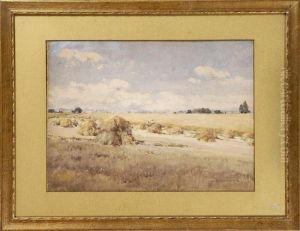W.H. Holmes Paintings
William Henry Holmes, often known as W.H. Holmes, was an American anthropologist, archaeologist, and geologist born on December 1, 1846, in Cadiz, Ohio. He was also a skilled illustrator and artist, which significantly contributed to his work in scientific fields. Holmes attended McNeely Normal School, now known as Hopedale Normal College, in Hopedale, Ohio, and later developed an interest in geological and archaeological pursuits.
Early in his career, Holmes joined the United States Geological Survey (USGS) as a topographic and geological illustrator, where his artistic talents were instrumental in the accurate recording of geological features. He was deeply involved in the survey of the Rocky Mountains and contributed to the pictorial documentation of the Hayden Geological Survey, which played a pivotal role in the establishment of Yellowstone as the first National Park in 1872.
Holmes's fascination with archaeology led him to focus on the ancient cultures of America, particularly the pre-Columbian civilizations. His most significant contributions to American archaeology were his studies of the ancient ruins in the southwestern United States and his work on the stratigraphy of prehistoric pueblo ruins, which helped establish a chronological framework for the region. He also served as the head curator of the Department of Anthropology at the Field Museum of Natural History in Chicago and later held the prestigious position of curator at the Smithsonian Institution's National Museum of Natural History.
Aside from his fieldwork, Holmes was an influential figure in the development of American anthropology and archaeology. He was a founding member of the Anthropological Society of Washington, and he succeeded John Wesley Powell as the second director of the Bureau of American Ethnology in 1902, a position he held until 1909. During his tenure, he promoted the systematic study of Native American cultures and the preservation of archaeological sites.
Holmes's artistic abilities were not just a professional tool; he was also recognized for his fine art, particularly his landscape paintings. His artwork, which often depicted American landscapes, was exhibited at the World's Columbian Exposition in 1893 and won an award.
William Henry Holmes passed away on April 20, 1933. His legacy is preserved through his numerous scholarly publications, art, and the impact he had on the fields of anthropology, archaeology, and geology. His work remains a reference for contemporary researchers and scholars in these disciplines.
